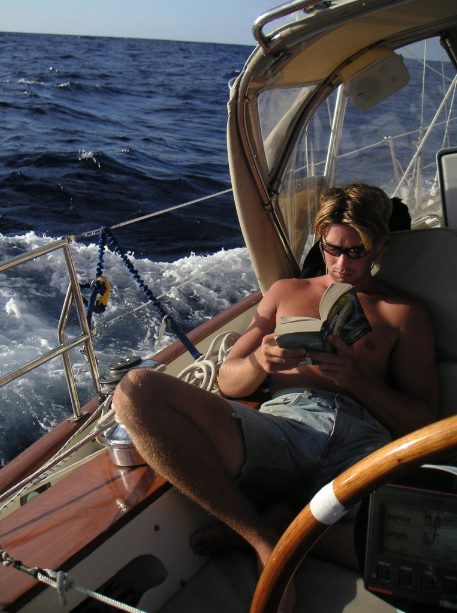Low Fuel
S 00 o 02 Minutes
W 88 o 47 Minutes
We are approximately 100 miles from Galapagos and have crossed the equator. (More on that in a later journal entry.) For now, here is the yesterday’s journal entry.
Journal Entry from
Sunday, 1600hrs EST, March 28, 2004:
N 00 o 38.376′
W 087 o 18.531′
(200 miles NE of Galapagos)
I noted with shock late Thursday that the fuel levels were down to less than a quarter tank, contradicting the assumption that we had at least two days of fuel available. The speed we have been maintaining, combined with the accessories we’ve been running with the help of the engine (watermaker, refrigerator, laptops, autopilot, etc.), has been consuming fuel at a rate of 1.8 gallons per hour. Back in November, when bringing Lillian south, the consumption had been less than 1 gal/hour. But in November, we were running with both sail and engine to power the boat, and we certainly weren’t running laptops, refrigerators, etc. Whatever the cause, since Thursday we have had to deal with the doldrums like sailors of old. When the wind drops, the sails flap as gentle Pacific swells roll the boat from side to side. The current still carries us westward, but at less than two knots our estimated time of arrival has changed from Sunday, to mid-week.
When on watch, the helmsman pays close attention to every nuance of wind and, in my case, I find myself trying to coax it by will power. Since that rarely works, the next step is to try to capture as many of the light breezes as possible while damping the roll of the boat by some untried combination of sail and trim. Unfortunately, when the air is light and seas gently rolling, there is no such combination. Attempts to the contrary usually give way to frustration, at which point the helmsman typically cleats the sails, pulls out a book, and lets the sails flap as they will until the wind returns.
Last night, at the midnight dividing Saturday and Sunday, Dick handed off the watch to me with a statement to the effect “We’re the only ones on the face of the earth.” Apparently a true enough statement, but of more interest to me was that a mild breeze had come up and Lillian’s mainsail and Genoa were filled, moving her along at a steady four knots. The watch that followed was idyllic. My first step was to unfurl the staysail. Not so much for the gain in speed, as the knowledge of how pretty Lillian looks when her mainsail and two foresails are out and full. The moon had set just before midnight, so there was only starlight to show her off, but starlight is sufficient. I thought back to one of my graduate school professors who once exclaimed upon the remarkable range of the human eye, which can see from blinding sunlight down into the twilight of a moonless night. Even with just the stars, the horizon was clearly discernable, and the rigging of the boat visible, if not distinct. The phosphorescent tail behind the boat was still evident, although not as bright as it was the first night out of Panama. The autopilot, “Hal,” was doing an excellent job of steering, so I took the opportunity to sit back in the helmsman’s chair and read Herman Melville’s Typee by pen light. Typee is Melville’s recounting of his time with the Typee cannibals in the Marquises Islands, over 150 years ago. We head to the Marquises after the Galapagos Islands, and to read his descriptions of the life and beauty of the islands is intriguing. So the night passed very peacefully, as we sailed the same waters as Melville.
At this rate, we should be in Galapagos by Tuesday, March 30th.
